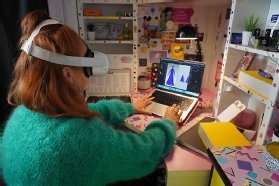
anutaray - stock.adobe.com
How 5G technology can help ignite the creative spark
Have you ever reached for a special bottle of wine only to realise the bottle opener is nowhere to be found? So much potential but no way to access it. In a way, it’s a problem affecting businesses right now regarding comms
The technology available to businesses and organisations is expanding faster than ever before. And as those tools, applications and systems become more sophisticated, getting the most from them requires more specialist tools.
When it comes to the internet of things (IoT), connectivity is like a bottle opener, with 5G one of the best wines on the market. A reliable and fast connection to the internet allows a host of IoT devices and data-driven applications like virtual reality (VR) and augmented reality (AR) avatars or immersive experiences to be connected.
Providing users with the ability to securely connect quickly and seamlessly with a variety of data sources will allow businesses to unlock a world of innovation and new potential. And for industries like fashion, film and gaming, 5G-enabled technology could be transformative.
Fashion’s high-speed revolution
Technology that was once the reserve of sci-fi films is now providing practical, real-life support to those working in fashion. In a boundary-breaking advancement for the industry, 5G is enabling creators and audiences to seamlessly connect and collaborate virtually – just look at the Hidden Floors project by Scotland Redesign that allowed local fashion designers to collaborate hundreds of miles apart and showcase their digital creations in a virtual exhibition space via a 5G network.

Not only have 5G-enabled technologies created opportunities to connect with buyers across the world, but they have also had a significant environmental and cost impact by reducing the need to travel to buyers or organise physical runway shows in different locations.
In fact, according to a report by ORDRE, from 2018 to 2019, an estimated 241,000 tonnes of CO2 emissions were released due to travel undertaken by buyers and designers attending international fashion weeks – that’s like burning 1,205 railcars’ worth of coal. This is one way that 5G-enabled technologies could help reduce the industry’s environmental impact.
Levelling up the gaming and eSports industry
Another creative cluster that has not only embraced but benefited from advanced connectivity is the gaming and eSports industry.
5G-enabled technology has taken sports entertainment to a whole new level. By providing low-latency, high-bandwidth connectivity, players can download large files quickly and stream seamlessly without any disruptions or lag. In an industry where a split-second can be the difference between winning and losing, a strong connection is vital.
And it’s not just for fun anymore, with some now valuing the UK’s gaming sector at £7.05bn with an estimated £350m contributing to the Scottish economy.
5G in VR and AR platforms also play a role in enhancing live streaming and audience spectatorship for eSports events. While these technologies aren’t new to the scene, they previously had to rely on a wired connection or chunky hardware to do the heavy lifting.
5G allows users to stream high definition (HD) content and supports interactions from multiple players at one time without the need for a tethered connection, creating a more collaborative and seamless gaming experience for fans and players alike.
Breaking boundaries in virtual production
In the film and broadcast industry, 5G will unlock new opportunities for content creation, distribution and consumption of digital entertainment. Having a faster, flexible and more reliable connection will allow production companies to stream HD videos and seamlessly upload large files to the cloud. Additionally, the ability to collaborate remotely in real time with the use of VR and AR technologies reduces production costs and timelines.

But that’s just the beginning. 5G is continuing to expand and, although its full potential is yet to be realised, Abertay University and a consortium of partners including ourselves are already making waves in the UK movie industry.
Using a new virtual production technique, actors can work together remotely but in real-time, linked by a 5G internet connection. Proving the sheer capability of a wireless virtual production, the project uses computer-generated imagery (CGI) and HD LED screens for motion capture to support real time interaction.
Not only is it a climate-friendly approach to production due to the reduced need for travel, it’s also a faster, less expensive and more effective alternative to green screens.
As an enabler technology, 5G’s enhanced capabilities can be the key creative organisations need to unlock the world of IoT and the benefits it can bring. As 5G continues to develop and evolve, it can turbocharge the future growth of the creative industries, giving organisations the tools they need to access different ways of working and collaborating. All it takes is a bottle opener.
Read more about 5G
- AiP advances ‘pivotal’ for 5G, 6G evolution: Research into antenna-in-package arena reveals how development in various substrate types and packaging methods can boost the roll-out of 5G mmWave networks and drive the forthcoming 6G market
- 5G-Advanced, RedCap set to drive 5G market in 2024: Latest evolution of next-generation mobile technology and low-load next-generation mobile wireless standard set to be key engines of 5G market.
- Swisscom taps Ericsson for 5G RAN framework: Leading Swiss operator deploys 5G RAN products and services to underpin and upgrade its mobile network.
- Businesses expect significant revenue growth through 5G: Research reveals two-fifths of organisations are upgrading to cellular connectivity to take advantage of technologies such as IoT and AI, but they risk leaving networks exposed to cyber attacks.







